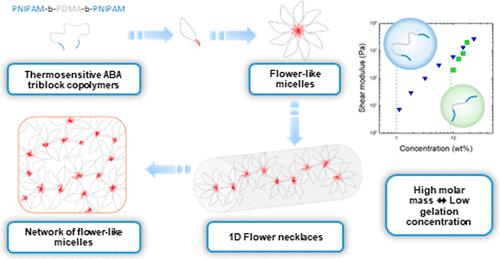Structure and Dynamics of Self-Assembled Thermo-Associative PNIPAM–PDMA-PNIPAM Triblock Copolymers of High Molar Mass
IF 5.2
1区 化学
Q1 POLYMER SCIENCE
引用次数: 0
Abstract
ABA triblock copolymers with thermosensitive poly(N-isopropylacrylamide) (PNIPAM) side blocks and high molar mass (>500 kg/mol) poly(N,N-dimethylacrylamide) (PDMA) central blocks were characterized in aqueous solution. Rheological studies revealed that using a large PDMA central block allows thermo-induced gelation at concentrations as low as 1 wt % and temperatures ranging from 28 to 38 °C in pure water, depending on PNIPAM concentration. Their temperature-induced self-assembly process was studied by static light scattering. In the dilute regime, the copolymers formed flower-like micelles. At higher concentrations, they formed 1D flower necklaces, which percolated when the semidilute regime was reached. This loose network structure gave rise to viscoelastic liquid behaviors at temperatures close to the sol–gel transition in the unentangled semidilute regime, with gradually increasing relaxation times as temperature was increased.

高摩尔质量自组装热缔合PNIPAM-PDMA-PNIPAM三嵌段共聚物的结构与动力学
在水溶液中表征了具有热敏性聚(N-异丙基丙烯酰胺)(PNIPAM)侧嵌段和高摩尔质量(>500 kg/mol)聚(N,N-二甲基丙烯酰胺)(PDMA)中心嵌段的ABA三嵌段共聚物。流变学研究表明,根据PNIPAM的浓度,使用大的PDMA中心块可以在低至1wt %的浓度和纯水温度范围从28°C到38°C的温度下进行热诱导凝胶化。通过静态光散射研究了它们的温度诱导自组装过程。在稀释状态下,共聚物形成花状胶束。在较高的浓度下,它们形成1D花项链,当达到半稀释状态时,它们会渗透。这种松散的网络结构在接近无纠缠半稀状态下的溶胶-凝胶转变的温度下产生粘弹性液体行为,随着温度的升高松弛时间逐渐增加。
本文章由计算机程序翻译,如有差异,请以英文原文为准。
求助全文
约1分钟内获得全文
求助全文
来源期刊

Macromolecules
工程技术-高分子科学
CiteScore
9.30
自引率
16.40%
发文量
942
审稿时长
2 months
期刊介绍:
Macromolecules publishes original, fundamental, and impactful research on all aspects of polymer science. Topics of interest include synthesis (e.g., controlled polymerizations, polymerization catalysis, post polymerization modification, new monomer structures and polymer architectures, and polymerization mechanisms/kinetics analysis); phase behavior, thermodynamics, dynamic, and ordering/disordering phenomena (e.g., self-assembly, gelation, crystallization, solution/melt/solid-state characteristics); structure and properties (e.g., mechanical and rheological properties, surface/interfacial characteristics, electronic and transport properties); new state of the art characterization (e.g., spectroscopy, scattering, microscopy, rheology), simulation (e.g., Monte Carlo, molecular dynamics, multi-scale/coarse-grained modeling), and theoretical methods. Renewable/sustainable polymers, polymer networks, responsive polymers, electro-, magneto- and opto-active macromolecules, inorganic polymers, charge-transporting polymers (ion-containing, semiconducting, and conducting), nanostructured polymers, and polymer composites are also of interest. Typical papers published in Macromolecules showcase important and innovative concepts, experimental methods/observations, and theoretical/computational approaches that demonstrate a fundamental advance in the understanding of polymers.
 求助内容:
求助内容: 应助结果提醒方式:
应助结果提醒方式:


